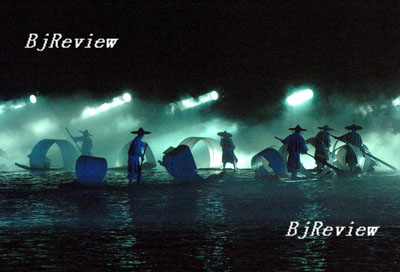 |
|
GOING COMMERCIAL: A scene from Impression Liu Sanjie, a unique show with nature as the backdrop (CHEN RUIHUA) |
Zhang Yimou, one of China's most successful filmmakers, said he will not shoot any new films for two years in order to prepare for the 2008 Beijing Olympics, for which he is the chief director of the opening and closing ceremonies. He is considered a leader in the "creative industry," and an increasing number of people in the field are getting inspiration from him.
The term, first used in Britain in 1997, is now widely used by Chinese Government officials, entrepreneurs and the media. It refers to industries "which have their origin in individual creativity, skill and talent." While many people still do not clearly know or understand the term, they are doing the job, and the industry is blossoming.
Impression Liu Sanjie, a performance presented in a natural stage setting that Zhang spent three and a half years developing, is widely recognized as an outstanding example of how the creative industry operates. In March 2004, the show premiered in Yangshuo County, Guilin, in south China's Guangxi Zhuang Autonomous Region.
The show, which employs local villagers and fishermen, is performed every night. The performance venue can hold 2,000 people, which can bring in 400,000 yuan in admission fees daily. It also helps to attract tourists worldwide, stimulating the development of local industries such as public transportation, hotels, restaurants and retail shops.
As a result, residents of the five surrounding villages have felt the positive effects of this development, which not only increases their income but also the local employment rate. Of the more than 700 performers and staff for the show, more than 200 are farmers hired from nearby villages.
"I did not mean to commercialize the performance when I started the project. Later, when I found that the show greatly promoted local economic development, I started to realize that the local culture has been commercialized," Zhang told Beijing Review.
According to Zhang, culture and tourism resources can be good for business. "China can always attract the world's largest number of tourists during its golden tourism weeks like the Spring Festival and National Day holidays," he said. "If local tourism administrations can combine their tourism resources with local culture and customs, they can find great business opportunities."
After Impression Liu Sanjie, Zhang was invited to direct Impression Lijiang. In contrast to Impression Liu Sanjie, it is performed during the day and does not have the spectacular lighting effects. "This is my new attempt as I want to maintain the original sense, and the audience can vividly see the blue sky, white clouds, mountain peaks and huge rocks," said Zhang.
Many provinces want to invite Zhang to create new ideas for them to tap into their tourism potential and some similar projects are under development. But according to Zhang, not every place is suitable for an "impression series" project.
A winning combination
Experts note that creative projects cannot be simply copied, and should be connected to the local culture. To them, Impression Liu Sanjie is a good example of combining the local character with creative ideas. The show is performed on the Lijiang River with 12 mountain peaks as the natural background, and the audience sits at the confluence of the Lijiang and Tianjiahe rivers.
According to Zhang, Guilin's scenery is unique in China. Meanwhile, Liu Sanjie, a very well known figure in Chinese tales who was not only a great singer but also helped common people struggle against evil forces, has become a symbol of Guangxi. The story was made into a film in 1960. The show retains some of the movie songs and scenery that are familiar to audiences and adds some new live elements such as shepherd boys, washerwomen, singing fisherman and cattle.
"It is different from common open-air theater performances. It does not have stars or luxurious sets. Here, the audience can only be moved by the excellent combination of Guilin's scenery and the local culture. This is the core part and inspiration of our creative industry," said Zhang.
Filmmaking is the first sector that Zhang commercialized. In mid-1980, most Chinese filmmakers did not considered the question of marketing and commercializing filmmaking. In order to illustrate their vision of art and personalities, they did not even consider the box office. Even 10 years ago, Chinese state-owned film studios did not have the consciousness to commercialize filmmaking.
| 